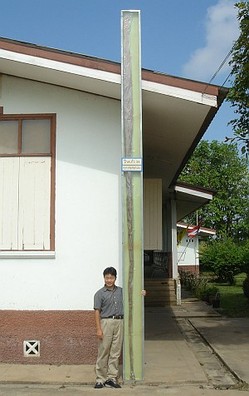Two genes involved in plant hormone signaling also help rice plants to survive floods

Fig. 1: When immersed during flooding, deepwater rice grows until the top leaves breach the water surface, giving the plant access to oxygen and allowing it to survive.
Over the generations, agricultural crops gain or lose genes that provide useful traits, such as the ability to withstand harsh or variable environments. A team involving Nagoya University's GCOE for Systems Biology1 have identified two such genes, SNORKEL1 (SK1) and SNORKEL2 (SK2), which help rice plants adapt to deepwater conditions and tolerate flooding.
The most important adaptations occur in plant internodes -- the sections of stem separating the nodes from which new stems or leaves arise. In plants that have adapted to deepwater conditions, the internodes grow into long, hollow snorkel-like structures that prevent drowning by allowing the exchange of gases with the air above (Fig. 1).
The researchers, led by Motoyuki Ashikari from the Bioscience and Biotechnology Center, showed that SK1 and SK2 encode proteins involved in ethylene signaling. When deepwater rice is submerged, ethylene -- a plant hormone previously implicated in the deepwater response -- builds up in tissues and switches on the SK genes.
Through DNA analyses, the researchers identified the SK genes as divergent members of the 'ethylene response factor' family of proteins found in other plants. The SK1 and SK2 proteins are expressed in cell nuclei, where they seem to activate other genes.
Further experiments confirmed previous findings that the plant growth hormone gibberellin (GA) is involved in deepwater response, and showed that signaling by SK proteins triggers internode elongation via GA.
Deepwater rice is grown in lowland areas susceptible to rainy season flooding, but has poor yield. "Combining SK genes with genes for increased productivity may help create high-yielding varieties able to grow in flood-prone areas," says Ashikari.
To assess the adaptive significance of SK genes, the researchers studied the expression of these genes in two wild progenitor species of cultivated rice Oryza sativa. They found that deepwater-adapted O. rufipogon possessed both SK genes and grew the snorkel-like structures when submerged.
A second wild progenitor species, O. nivara, showed little response and turned out to have an inactive SK2 gene, although SK1 was functional. "It appears that SK2 has a more pronounced effect than SK1, and because some O. nivara are adapted to dry areas, this may have led to its adaptive loss," says Ashikari.
This suggestion is supported by the observation that O. glumaepatula, a wild species found in flood-prone areas along the Amazon River, lacks SK1 but possesses SK2 and other SK2-like genes.
Based on their findings, the researchers propose that wild rice may have acquired SK genes before or during their evolutionary divergence from other plants.
Affiliated Researchers
The Nagoya University affiliated researchers mentioned in this highlight are from the Advanced Systems Biology GCOE, the Bioscience and Biotechnology Center and the Graduate School of Bioagricultural Sciences.
Reference
Hattori, Y., Nagai, K., Furukawa, S., Song, X-J., Kawano, R., Sakakibara, H., Wu, J., Matsumoto, T., Yoshimura, A., Kitano, H. et al. The ethylene response factors SNORKEL1 and SNORKEL2 allow rice to adapt to deep water. Nature 460, 1026-1030 (2009). | article